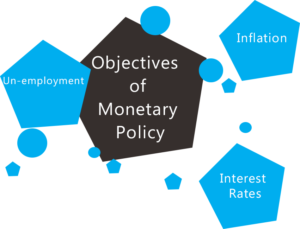Monetary policy in Forex is a governments policy through the Central banks to control the amount of money in circulation. Its aim it to stablise prices and economic development.
The central banks operate under the rules of the government to regulate money circulation with a goal of achieving economic stability and development.
Monetary policy is applied in 2 ways;
- Expansionary monetary policy
- Contractionary or Restrictive monetary policy

The main aim of the government is to;
- Control inflation
- Regulate the money supply
- Regulate interest rates of commercial banks
- Improve economic development
- Trade balances
How does monetary policy work?
The government uses the expansionary monetary policy when it wants to increase money supply.
Expansionary Policy
- The central bank cuts interest rates to make borrowing cheap and encourage spending on goods and services.
- It reduces on the reserves required by the central banks from commercial banks. This increases the amount of money available in banks for borrowing.
- The Open Market Operations(OMO). In this case, the central bank encourages its citizens to sell their securities like bonds, treasury bills to the government for cash at a profitable amount.
As more money gets into circulation, it speeds up economic development and standards of living of people.
As a result, demand for goods and services increase.
When people get more money they spend more. Demand overwhelms supply and prices keep increasing.
This weakens the domestic currency and makes it expensive to spend on foreign goods.
The persistent increase in prices slows down the economy because people buy less with much money so the currency value eventually falls.
Inflation leads to high prices, high costs of production, demand for increased wages hence unemployment and poor standards of living.
When this happens, the government intervenes to save the economy by using the Contractionary or Restrictive monetary policy.
Contractionary or Restrictive policy
- The Central bank Increases interest rates to discourage borrowing to spend. It also attracts foreign investors interested in the high yield returns to invest.
- High Interest rates also encourage citizens to save in the bank hence reducing on the disposable income and expenditure.
- Similarly, the Central bank can also increase bank reserves and encourage the public to invest in government securities to regulate money supply.
It’s the role of the Central banks to regulate these situations and in order to maintain the economic balance.
Therefore, it is important to always know when such important data is to be released so that you are able to adjust to certain changes in the market.
Hawkish vs Dovish Central banks
These two sound like birds names, hawks and doves; Interestin’!
But that’s not the case. Hawkish and Dovish means raising interest rates or lowering them.
The two terms describe opinions taken by Central Banks on the issue of interest rates.
The Central Bank is either hawkish or dovish depending on the approach it uses while determining the interest rate.
A Dovish Central Bank.
Here the Central bank cuts interest rates to encourage the public to borrow for expenditure. Low interest rates make borrowing and spending very cheap.
Hawkish Central Bank
This when the monetary policy is to raise the interest rate to curb down inflation and improve the economic growth.
Effect on the forex market
When the Central Bank cuts interest rates to boost domestic expenditure, it increases amount of money in circulation.
This makes the local currency cheap abroad hence a fall in its value.
As a result foreign investors start to sell off the currency and opt for more yielding currencies.
The expansion monetary policy makes the Forex market more bearish due to expected fall in value of the currency in question.
On the other hand, when the Central Bank raises interest rates, its aim is to reduce the amount of money in circulation.
When this happens, currency gains value and more investors buy more of the currency. This makes the Forex market more bullish.
This is because hiking of interest rates is a sign of good economic growth in the country in question.
Risk Reward ratio Quadrants: The Difference between Amateur and Professional Traders!
Risk reward ratio (RR) is the “holy grail” of trading. Risk reward ratio Quadrants identify where you actually belong in your trading business. RR is the most important metric in trading and a trader who understands it can greatly improve his/her chances of becoming...
- Oh, bother! No topics were found here.



